Potrebujeme váš súhlas na využitie jednotlivých dát, aby sa vám okrem iného mohli ukazovať informácie týkajúce sa vašich záujmov. Súhlas udelíte kliknutím na tlačidlo „OK“.
ASTM D6442-06(2012)
Standard Test Method for Determination of Copper Release Rate From Antifouling Coatings in Substitute Ocean Water
Automaticky preložený názov:
Štandardná skúšobná metóda pre stanovenie medi Release sadzbu z proti zanášaniu povlaky Náhradník vody oceánu
NORMA vydaná dňa 1.6.2012
Informácie o norme:
Označenie normy: ASTM D6442-06(2012)
Poznámka: NEPLATNÁ
Dátum vydania normy: 1.6.2012
Kód tovaru: NS-35158
Počet strán: 10
Približná hmotnosť: 30 g (0.07 libier)
Krajina: Americká technická norma
Kategória: Technické normy ASTM
Kategórie - podobné normy:
Anotácia textu normy ASTM D6442-06(2012) :
Keywords:
antifouling coating, copper, release rate, ICS Number Code 87.040 (Paints and varnishes)
Doplňujúce informácie
| Significance and Use | ||||||
|
4.1 This test method is designed to provide a laboratory procedure to quantify and characterize the release rates of copper from antifouling coatings in substitute ocean water over a period of immersion under specified laboratory conditions of constant temperature, pH, salinity, and low copper concentration. Quantitative measurement of the release rate is necessary to help in selection of materials, in providing quality control, and in understanding the performance mechanism. 4.2 Results from this test method establish a pattern of copper release from an antifouling coating over a minimum of 45 days exposure under controlled laboratory conditions. Copper release rates from antifouling paints in-service vary over the life of the coating system depending on the formulation and on the physical and chemical properties of the environment. Factors such as differences in berthing locations, operating schedules, length of service, condition of paint film surface, temperature, pH, and salinity influence the actual release rate under environmental conditions. Results obtained using this test method do not reflect actual copper release rates that will occur in-service, but provide comparisons of the release rate of different antifouling formulations in substitute ocean water under the prescribed laboratory conditions. 4.3 By comparison with copper release rate measurements obtained either by direct measurements of copper release rate from AF coating systems on ship hulls, or copper release rate measurements from AF coating systems from harbor exposed panels, all available data indicate that the results of this test method (Test Method D6442) significantly overestimate the release rate of copper when compared to release rates under in-service conditions. Published results demonstrate that this test method produces higher measurements of copper release rate than from direct in-situ measurements for the same coating on in-service ship hulls and harbor-exposed panels. The difference between the results of this test method and the panel and ship studies was up to a factor of about 30 based on data for several commercial antifouling coatings.4.4 Where the results of this test method are used in the process of generating environmental risk assessments, for environmental loading estimates, or for regulatory purposes, it is most strongly recommended that the relationship between laboratory release rates and actual environment inputs is taken into account to allow a more accurate approximation of the copper release rate from antifouling coatings under real-life conditions. This can be accomplished through the application of appropriate correction factors.4 |
||||||
| 1. Scope | ||||||
|
1.1 This test method covers the laboratory determination of the rate at which copper is released from an antifouling (AF) coating in substitute ocean water. The practical limits for quantifying copper release rates by this method are from 1.8 to 500 μg cm-2d-1. This range may be extended to 0.2 to 500 μg cm-2d-1 if the analytical procedure described in 1.2 The procedure contains the preparation steps for the release rate determination of copper from antifouling paints including apparatus, reagents, holding tank conditions, and sampling point details. Analysis for the concentration of copper in substitute ocean water requires the accurate determination of copper at the low parts μg L-1 (parts per billion, ppb) level. To detect and correct for reagent impurities, acceptable analytical precision standards are necessary. Therefore, the limit of quantitation (LOQ) for copper in substitute ocean water for the analytical method shall be 10 μg L-1 (10 ppb) or less. The procedure for determining the LOQ for copper in substitute ocean water for the analytical method is found in 1.3 A suitable method is described in 1.4 This results of this test method do not reflect environmental copper release rates for antifouling products, and are not suitable for direct use in the process of generating environmental risk assessments, environmental loading estimates, or for establishing release rate limits for regulatory purposes. See also Section 4 on Significance and Use. 1.5 The values stated in SI units are to be regarded as the standard. The values given in parentheses are for information only. 1.6 This standard does not purport to address all of the safety concerns, if any, associated with its use. It is the responsibility of the user of this standard to establish appropriate safety practices and to determine the applicability of regulatory limits prior to use. For specific hazard statements, see Section 7. |
||||||
| 2. Referenced Documents | ||||||
|
Podobné normy:
Historická
15.3.2013
Historická
1.1.2014
Historická
1.11.2008
Historická
15.5.2010
Historická
1.6.2011
Historická
1.12.2010


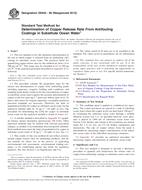
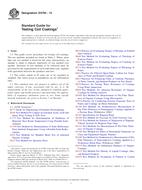 ASTM D3794-13
ASTM D3794-13 ASTM D3891-08(2014)..
ASTM D3891-08(2014)..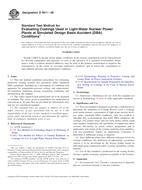 ASTM D3911-08
ASTM D3911-08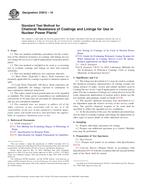 ASTM D3912-10
ASTM D3912-10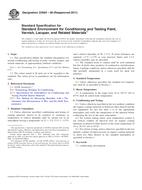 ASTM D3924-80(2011)..
ASTM D3924-80(2011)..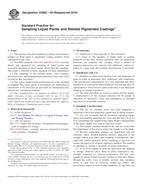 ASTM D3925-02(2010)..
ASTM D3925-02(2010)..
 Cookies
Cookies
